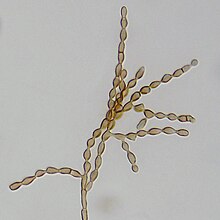Cladosporium cladosporioides
| Cladosporium cladosporioides | |
|---|---|
 |
|
| Scientific classification | |
| Kingdom: | Fungi |
| Division: | Ascomycota |
| Subdivision: | Pezizomycotina |
| Class: | Dothideomycetes |
| Order: | Capnodiales |
| Genus: | Cladosporium |
| Species: | C. cladosporioides |
| Binomial name | |
|
Cladosporium cladosporioides (Fresen.) G.A. de Vries, (1952) |
|
| Synonyms | |
Cladosporium cladosporioides is a darkly pigmented mold that occurs world-wide on a wide range of materials both outdoors and indoors. It is one of the most common fungi in outdoor air where its spores are important in seasonal allergic disease. While this species rarely causes invasive disease in animals, it is an important agent of plant disease, attacking both the leaves and fruits of many plants. This species produces asexual spores in delicate, branched chains that break apart readily and drift in the air. It is able to grow under low water conditions and at very low temperatures.
Georg Fresenius first described Cladosporium cladosporioides in 1850, classifying it in the genus Penicillium as Penicillium cladosporioides. In 1880 Pier Andrea Saccardo renamed the species, Hormodendrum cladosporioides. Other early names for this taxon included Cladosporium hypophyllum, Monilia humicola and Cladosporium pisicola. In 1952 that Gerardus Albertus de Vries transferred the species to the genus Cladosporium where it remains today.
Cladosporium cladosporioides reproduces asexually and because no teleomorph has been identified, it is considered an exclusively anamorphic species. Colonies are olive-green to olive-brown and appear velvety or powdery. On a potato dextrose agar (PDA) medium, colonies are olive-grey to dull green, velvety and tufted. The edges of the colony can be olive-grey to white, and feathery. The colonies are diffuse and the mycelia form mats and rarely grow upwards from the surface of the colony. On a malt extract agar (MEA) medium, colonies are olive-grey to olive or whitish due to the mycelia growing upwards, and seem velvety to tufted with olive-black or olive-brown edges. The mycelia can be diffuse to tufted and sometimes covers the whole colony. The mycelia appear felt-like, grows flat, and can be effused and furrowed. On oatmeal agar (OA) medium, colonies are olive-grey and there can be a gradient toward the edges of the colony from olive green to dull green, then olive-grey. The upward growth of mycelia can be sparse to abundant and tufted. The mycelia and can be loose to dense and tends to grow flat.Cladosporium cladosporioides has sparse, unbranched or rarely branched, darkly-pigmented hyphae that are typically not constricted at the septa. Mature conidiophores are treelike and comprise many long, branched chains of conidia.Cladosporium cladosporioides produces brown to olive-brown coloured, solitary conidiophores that branch irregularly, forming many ramifications. Each branch tends to be between 40–300 µm in length (exceptionally up to 350 µm) and 2–6 µm in width. The conidiophores are thin-walled and cylindrical and are formed at the end of ascending hyphae. The conidia are small, single-celled, lemon-shaped and smooth-walled. They form long, fragile chains up to 10 conidia in length with distinctive darkened connective tissue between each spore.
...
Wikipedia
